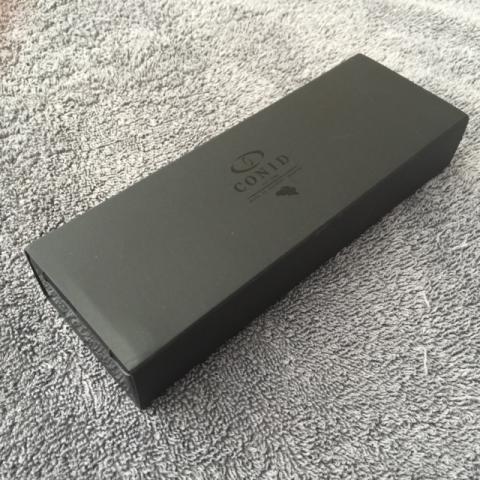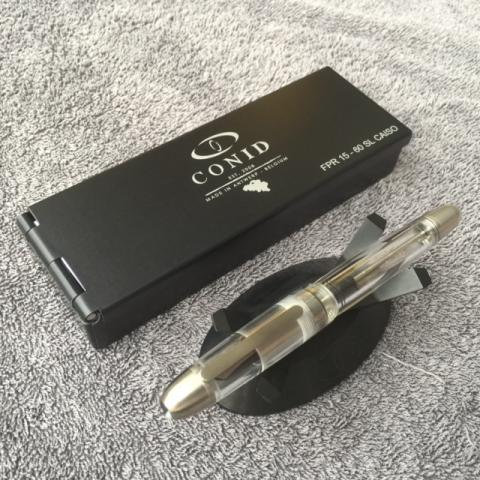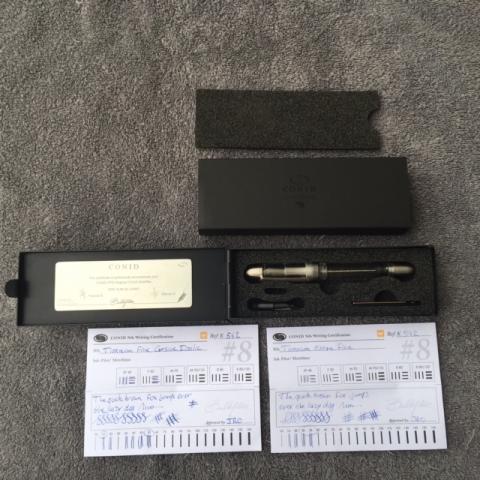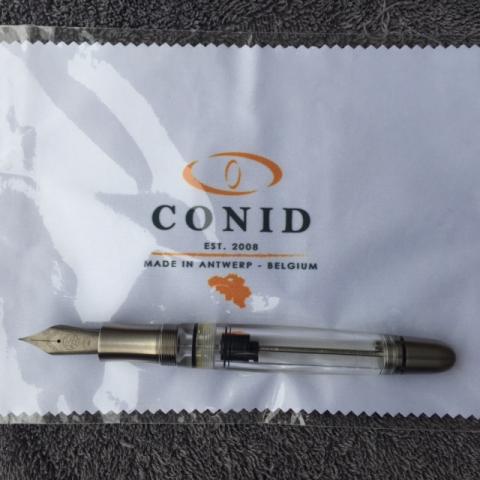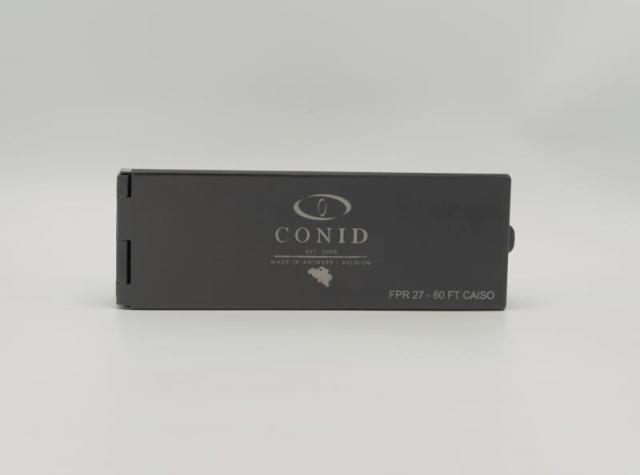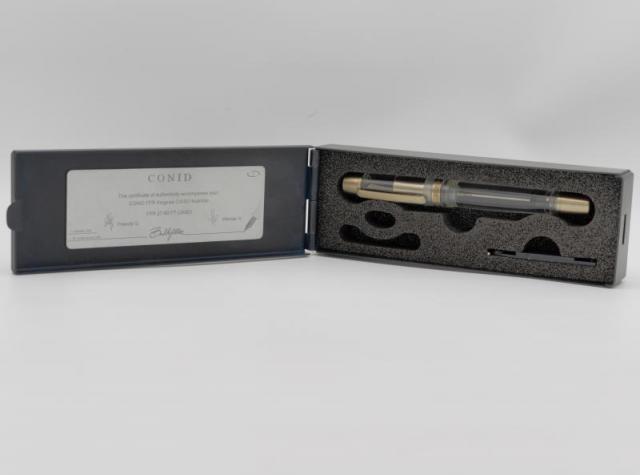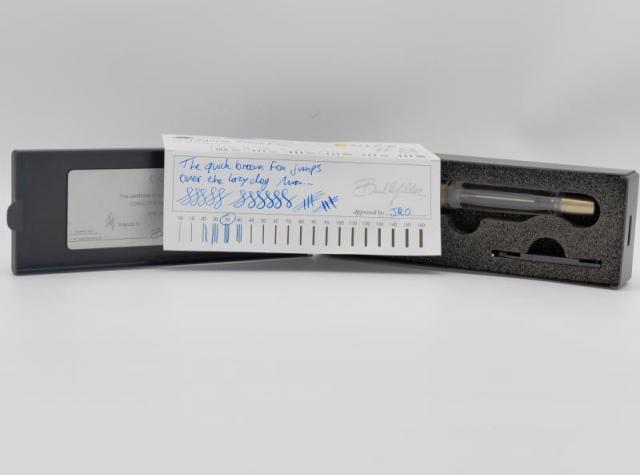Search the Community
Showing results for tags 'caiso'.
-
I contacted Conid back in April '19 to ask when they expected to reintroduce the CAISO system to their Kingsize pens, and Jonas wrote back to say it is definitely coming back but gave no date, it's awaiting improved engineering.... Does anyone have any updated info on when this feature will be returning? And if you have a pen with it installed, is it worth waiting for?
-
CONID currently does not sell the Kingsize Bulkfiller with the CAISO system - apparently they are ironing out some manufacturing issues. Based on email communication, it seems they will not be back until April at the earliest (six months from now). They do sell a non-CAISO Kingsize Bulkfiller, though, and it's €300 cheaper than the CAISO version used to sell for. My question is thus, mostly addressed to people who've tried a CAISO pen: is it worth the money and the extra wait, or should I just order the non-CAISO version? The cost is the lesser concern, since this is an expensive pen either way, so I'm mostly curious about whether you find the CAISO system useful, or just a gimmick.
-
See the photos here https://flic.kr/p/L6WAS1 The Conid company is not as widely known as others. If this is your first exposure to it, take a look at their website and read through their information. There are also numberous posts about their pens. I came across it a year ago and become very interested in their design/manufacturing capabilities and the advances they were making with fountain pen manufacturing. In a market that has had very few real advances over the years, it is really refreshing to see how they are using very tight tolerance manufacturing to bring their ideas to life. A lot of us have been waiting for the Conid CAISO Kingsize Bulkfiler fountain pens since they were introduced as a concept model in 2015. I sold about $1,400 worth of fountains pens to get ready. Part of that was in hopes that the new Conid would be the ultimate daily user, and that I wouldn't need too many other pens. Also, I needed funds to make the purchase. I jumped on board when the order form was available on the Conid website and was hopeful that I would see the pen in a few months. It took little longer to get the pen fully ready for prime time. The last item to get right was the feed. The designers originally made a clear feed, but they were not able to get the performance and reliability for the unique ink shut off capability of the pen, so they manufactured the feeds from hard rubber. The pen has a huge capacity, and an automatic ink shut-off when capped, useful for those flying regularly. I received my pen this week, one of 60 from the First Production Run (FPR). There was also a flat top version with 60 units available. The discussion of the design of this model could fill many pages. If you want the history of the design, there is a great discussion of the Conid Caiso here: https://www.fountainpennetwork.com/forum/topic/283524-new-caiso-bulkfiller-revealed/page-1710 Appearance & Design - 9 The pen is outstanding! If you need any more detail, please read on. The photos of the pen online were a great teaser as we waited for the pens to be completed and sent to the customers. It was exciting to receive the package and open it up, to finally see the pen in person, and be able to try all of the features. My initial impression was mixed. The CAISO demonstrator is a pen that will meet my needs, for a lifetime. It is not a gorgeous pen like some of those that I sold. More on that as I go through the features. Construction & Quality - 10 The CAISO is made almost entirely of titanium and clear acrylic. It has an engraving near the blind cap that is essentially a serial number. This pen has "FPR 15-60 SL". It is the First Production Run of this model, and is #15 of 60 total pens, in the streamline (SL) version. They also made 60 units of a flat-top. The band on the cap has "Conid Bulkfiller Fountainbel". The clip is made of a single piece of titanium that is machined to shape. Conid has posted a video of numerous manufacturing steps on their website, part of which shows the clip being made. The top of the cap is titanium with a black/white acrylic inset representing the piston mechanism. The pen feels very smooth and exudes quality. I didn't detect any manufacturing flaws. The only thing I noticed that is not uniform is that the portion of the barrel behind the section and threads is slightly yellow. It may be adhesive. I remember reading some where that the entire pen is screwed together except for one part. The pen should wear well, looking essentially the same after years of use. The clip is very tight. Once clipped, it is unlikely to be inadvertently dislodged. Weight & Dimensions - 9 The pen is fairly weighty, but feels very nice in use. It is approximately the size of a Montlanc 149. The cap does post, but it takes a little extra effort to make it tight. The pen writes well either way. I may post it when writing for extending periods of time, but use it unposted for quick notes. Unposted, the pen is long enough to extend well beyond the web of my hand. Nib & Performance - 9 The pen can be ordered with #8 Bock made nibs of various materials: steel, titanium or gold. I ordered the pen with a Fine titanium nib, modified to an Extra Fine. Later I decided to add a Fine titanium modified to a smooth cursive italic. When the pen was ready to be sent a couple weeks ago, Conid sent a photo of the pen with samples of the writing with each nib. That was cool! The extra fine nib was about perfect for me, great for notes and general writing. It had slight feedback, but it wasn't too bad. After some use though, it has gotten very smooth and consistent. Under a loupe, I discovered a very well tuned nib. Some nib meisters remove most of the tipping material to make narrow nibs, but this wasn't the case on the Conid. The flow is nice, about a 7 out of 10. I received a second section with the cursive italic nib installed. That nib also has a large amount of tipping remaining. It has a gap between the tines to allow for more flow. It writes very smooth and has nice variation for the narrow width that I wanted. Both nibs were very well tuned. The additional cost was 25 pounds, I believe, and based on competitors pricing, I wasn't expecting top notch performance. This is one of the best kept secrets in the fountain pen world. Fountainbel is a long time fountain pen user and repair expert, and his nib work is outstanding! It is easy to change out the nibs, but the titanium rod through the middle needs to be transferred when swapping nibs. My only issues with the nib choices is not to be able to get one that is branded by Conid in this size. The smaller models have a #6 nib with a unique Conid graphic. The nibs that come with the CAISO do not take away from that pen, but a Conid unique nib would make the pen even more classy. Filling System & Maintenance - 10 The CAISO mechanism is a combination of a stem in the top of the cap, and a rod through the feed that seals the ink chamber when capped. When the cap is removed, the rod is pulled out slightly, opening the ink chamber for use. It is seamless, requires no additional thought or effort, but does add slightly to the effort needed to cap and up cap the pen. The piston stays near the blind cap most of its life, but the value of their filling system is that the piston moves nearly the full length of the barrel through the use of a piston rod that screws into the piston to move it, but then disengages after it is filled. The pen doesn't need very much room at the end of the barrel for the piston, unlike telescoping pistons. A huge advantage of this mechanism for me is that flushing is very simple and effective. Rather than turning a knob to move the piston, this is a simple push/pull. The pen holds over 3 ml of ink when fully filled. That is enough to last me for months probably. I like to fill the pen partially and be able to see the ink move around and expose the piston rod. The shape of the barrel behind the section is especially nice, similar to an hourglass. For maintenance, the piston can be removed with Conid-provided tools for cleaning and lubricating. The nib section can easily be unscrewed for ultrasonic cleaning and to flush out the barrel. Cost & Value - 7 The cost of this pen is assumed to be based on the complexity of the filling system, the maching of the titanium parts, the close tolerances, the new ink shut off system, etc. Most other high end pens are either very decorative, using gold, sterling, etc. or made with somewhat delicate materials, like urushi. The reasons I sold other pens (Danitrio, Nakaya, Namiki) to buy this one were exclusivity, durability, size, and performance. If I bought the pen without selling others to fund it, the price would have been painful. I have no regrets buying this pen, and plan to keep it for one of my children to use one day. Was it worth it? This style won't appeal to everyone; some want gold trim, some want urushi, some lightweight, etc. It is a completely functional pen that is unique. It is not pretentious; I have no problem using it in meetings or amoung strangers. Previous pens have seemed to flashy or expensive looking to use in public. For my use, this pen is as good as it gets! Conclusion - 5.4/6 The score may seem low for a pen that I like so much. The proof is that I sold others pens to buy this one and do not regret it! No pen is perfect, as is evidenced by the buying and selling of fountain pens worldwide. Is there anyone out there who has bought a pen and never looked for another with other features? Not many of us on this form have been able to do that! I really am glad that I got in on this pen model release from Conid. It is similar to their regular Kingsize, but adds the CAISO system and more titanium. Conid ships their pens in a custom anodized aluminum case that holds the pen, tools, and extra nibs. The inside of the lid has a titanium name plate with the model nomenclature. Very cool! Conid added a pen stand for this model that was previously not available on their website. The pen stand is fully functional and looks good. It feels somewhat soft, and I don't worry about putting the pen on it and getting wear marks. The stand adds value to the pen. Well done Conid! This pen was a home run!
- 57 replies
-
- fountain pen
- conid
-
(and 3 more)
Tagged with:
-
As a multi-time poster on FPN, it struck me today that I'd never taken the time to write a review of any of my favorite fountain pen examples. It's not that I hadn't figured that I should before; I've never felt moved or compelled by a writing instrument to take the time to write down my thoughts - ironic given my love for pens and writing. That said, when I came home yesterday and saw a note on my door telling me that I'd missed a package from Antwerp, I was both so incredibly excited for the wait to be over, and so incredibly disappointed that I'd have to wait another day. So today, I went out, picked up my package from the post office, grabbed lunch, came home, set up my portable photo tent for when I'm out of my studio, and opened the package. Firstly, the package. An beautifully crafted box, from the outer sleeve with its lovely embossing to the inner aluminum packaging. Everything down to the carving of the inner foam is on point and perfectly executed. It's a marvel to look at. Additionally, the nib stroke sheet is helpful and shows Conid's commitment to accuracy and consistency. Next up is the nib. I ordered a Fine titanium ground down to an Extra Fine titanium for my example. This is my second Conid, with a Slimline Titanium Fine stub as my first. I love the stub, although the edges can catch paper fibers and cause some scratching. That said, when it hits the sweet spot, it's very sweet. This example's EF is simply incredible. When I put the nib to the page, ink just started to flow. And flow. And continue to flow. This might be the most pleasantly wet and smoothe nib I own, literally gliding across the page. With some titanium nibs (I swapped, for example, my TWSBI Vac 700 and Diamond 580al steel nibs for Titanium Bock Fine nibs) and found them to be a little scratchy. With the CAISO, Fountainbell's nib work is outstanding, and I have to give him some serious kudos for his attention to detail and professional skill. Let's swing over to the barrel. Smoothe, with a lovely cool texture and beautiful titanium fittings, it looked beautiful, albeit a little utilitarian before, filling. Sharing a photo, I was told it looks "quite masculine," and I can understand, in many ways, why. That said, its image completely changes when filled with ink, maximizing the body and accentuating the curve throughout the center. It almost becomes a completely different pen with every fill. In the hand, it feels just right: weighty, but not overly so, well balanced, cool, smoothe with some feedback, and just the right width to be comfortable. The (not so) blind cap is beautiful, sitting flush against the clear acrylic connecting to the machinery inside, while the titanium milled cap body and cap balances out the other end. Conid logo sits tucked into the cap made from acrylic. It's so well polished, you can't tell any separation between the acrylic from the logo and the titanium of the cap. Conid's attention to detail, as many has said, is outstanding, and I'm still blown away by how precise a job they've done. Then there's the most interesting part of the pen: the cap-actuated bulkfiller. At this point, the Bulkfiller mechanism is fairly well known. You write a syringe by turning the blind cap, pull it back, screw it into a plunger screwed into the back of the pen, press the syringe down, submerge into ink, draw ink into the pen, spin the syringe in the opposite direction until it unscrews from the plunger, and press the syringe back down into the pen. It's much easier to see than describe, so watch an animated video here: Or watch Francis (fountainbell) filling a regular Bulkfiller here: Most Bulkfillers seal when screwed all the way down, making flying, travel, and storage simple. This pen's mechanism is cap actuated. When you put the cap on, a plug in the cap depresses a needle in the feed, which seals the section from the main body of the pen. Ink is sealed away from passing into the feed, until you remove the cap again. For frequent travelers (who don't write as they fly, as removing the cap will open the feed to the main body of the pen again) this is a wonderful addition. Beyond that, from a technical perspective, it's quite the feat of precision engineering, and Francis has really outdone himself. There's only one downside, as I can see it, to this system: the plunger in the cap covered in ink when it screws into the feed upon closing. For those of us with a minor obsession with keeping out pens clean, that can be a bit of a headache. That said, it's a tiny tradeoff for everything else this pen provides. Size wise, the pen is larger posted than the Montblanc 147, but smaller than the posted Visconti Homo Sapiens. Posted, it's slightly larger than the Conid Slimline, but feels much more substantial in the hand. That said, the Slimline holds 2ml, while the the Kingsize holds a whopping 3ml of ink, at a complete fill. Size wise, it's almost exactly as long as the TWSBI Diamond 580 when capped. There is a significant weight difference, as well, given that the Diamond 580 holds significantly less ink. The pens also feel considerably different from a material perspective, as the Kingsize was CNC'd, I believe, from a solid piece of acrylic while the TWSBI's shape was injected into a mold. The quality difference is apparent as soon as you take the pen out of its case. I'm stunned by this pen. I have plenty of pens, from $3 Jinhao that write expertly to $7000 Montblanc that I'm not convinced I'd ever write with. That said, this has to be the single most well constructed and precision manufactured pen I've received, with what may be my favorite nib out of any pen I own. Yes, I know, I've been gushing this whole review (I never actually intended to write a review, but just post photos for folks who were curious), but as I said at the beginning, I was more moved to write this than anything. I have a feeling that this pen just made it to the top of my rotation, and will probably stay there for a while. Now I just have to figure out how to order additional nibs, and I'll be all set. For good measure I included a few photos of the Kingsize along with the Slimline.



